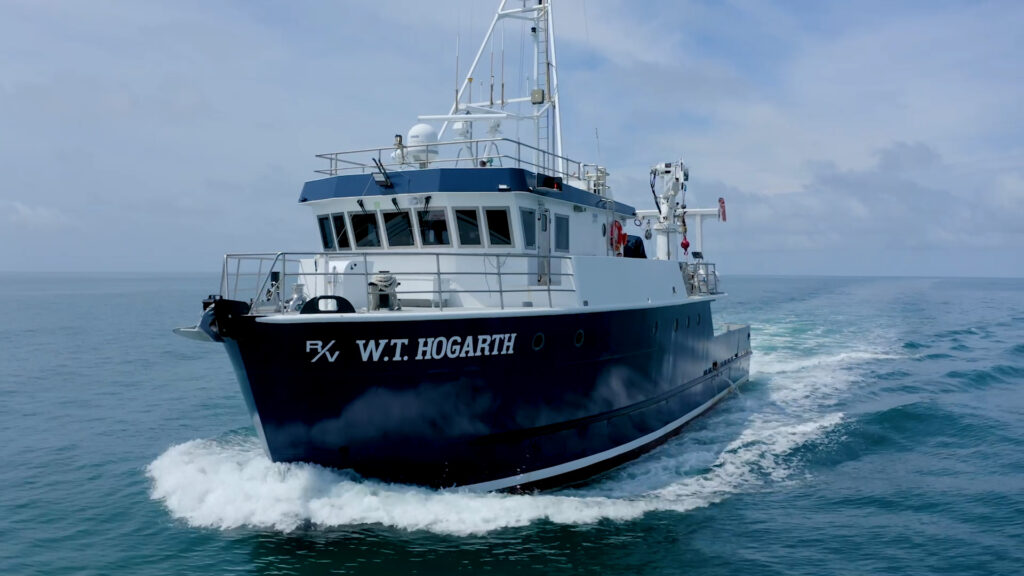
Do hurricanes make red tide worse? How are creatures that live on the bottom of the sea dealing with the aftermath of Hurricane Ian? What about coral reefs? Oh, and is there abundant evidence of pollution in the Gulf following this ecological disturbance?
Researchers from The Water School at Florida Gulf Coast University are seeking answers to these questions and many others right now. In partnership with the Florida Institute of Oceanography (FIO) and the Sanibel-Captiva Conservation Foundation (SCCF), students and faculty members are aboard the W.T. Hogarth on one of the first long-term research voyages since Hurricane Ian wracked Florida’s southern Gulf coast in late September.
“A hurricane is not only a natural disaster, but it’s a big dump of man-made pollution into the Gulf,” said James Douglass, Ph.D., associate professor of marine science in The Water School at FGCU. “Both the natural and man-made effects can really change the environment out there, and so we’re trying to capture those changes with this shortly after the hurricane analysis.”
Seven FGCU researchers are on board, including two graduate and two undergraduate students.
“It is incredible that I got to be one of the students to be a part of this,” said Susannah Cogburn, a senior from Orlando pursuing her bachelor’s in marine science.
Cogburn typically works on red tide research alongside noted Water School professors Mike Parsons, Ph.D., and Puspa Adhikari, Ph.D. For this trip, she will take what she learned from them and put it to work on the open sea. It’s an experience she doesn’t want to waste.

“I’ve been on different research trips but never something like this for so long on a research vessel. I’ve done the day trips on the Hogarth for class, but it will be interesting to see the differences. Being on that one-day trip to being on a trip that’s seven to 10 days long, to learn all the different sampling techniques and different oceanographic instrumentation usage, I think it will be really impactful for my future career as a marine scientist,” she said.
FGCU’s Adhikari, one of Cogburn’s mentors, spearheaded planning for the trip in the storm’s wake.
“Our main research station, Vester Field Station at Bonita Springs, is damaged [due to storm surge], and it is likely we won’t be able to use it until summer 2023. The support from FIO to recover our currently deployed instruments and post-hurricane sample collection will be greatly helpful,” he said.
FIO is capitalizing on its partnerships across the state, and its members have stepped up to provide data, logistical support, equipment and scientific supplies for this voyage. These efforts include multiple institutions within the FIO Consortium, including the University of South Florida’s College of Marine Science, Florida Atlantic University’s Harbor Branch Oceanographic Institute, University of Florida, Florida Agricultural and Mechanical University, Florida Fish & Wildlife Conservation’s Fish and Wildlife Research Institute and the Florida Department of Environmental Protection.
“Like FIO’s response to the Piney Point discharge event, the deployment of resources to the areas impacted by Ian shows the importance of our state-supported mission. We are focused on bringing the best science capabilities of Florida’s universities and organizations to the forefront of these coastal ecosystems to better understand the storm’s overall impact,” said Monty Graham, Ph.D., FIO’s director.

Researchers are concerned with the potential development of a red tide bloom in the wake of Hurricane Ian’s floodwaters. Red tide blooms typically occur in Florida in the fall, and hurricanes are suspected of playing a role in stimulating blooms. The heavy rainfall and flooding cause land-based nutrients to flow outward to coastal waters, and blooms feed off those nutrients. Hurricanes Irma and Maria likely exacerbated the massive red tide bloom of 2018. Data collection around Fort Myers will focus on water quality and the hurricane’s impact on coastal geology. Scientists at FGCU and SCCF have long-term data to evaluate how the storm affected local ecosystems and water quality.
Adam Catasus, coordinator of education and research at FGCU’s Vester Field Station, said capturing data immediately following a big storm is extremely important but can be difficult.
“It’s usually very hard because there is so much destruction [from hurricanes],” Catasus said. “We’re really lucky to have the opportunity to work with the Florida Institute of Oceanography to use one of their vessels and get out there. Determining these impacts can really make a difference on how we manage our offshore resources on the west coast of Florida.”
Holding a bachelor’s and master’s from FGCU, Catasus follows the lead of his Water School professors – acknowledging the economic and environmental importance of the Gulf to Southwest Florida. It’s why the work to learn more about red tide is vital to this region.
“I’m hoping to not find a red tide bloom,” Catasus said.

Even if the crew doesn’t find red tide, there will be noticeable changes to the Gulf.
“We’re almost three weeks post-hurricane, but the effects are going to be long-lasting. We think it’s going to be a long road to recovery environmentally,” he said.
Together, this team of FGCU Water School researchers and an SCCF scientist, not to mention a TV crew from WINK News documenting the findings, hope to bring back a clear snapshot of what we have yet to see from Hurricane Ian’s wrath.